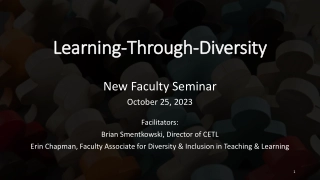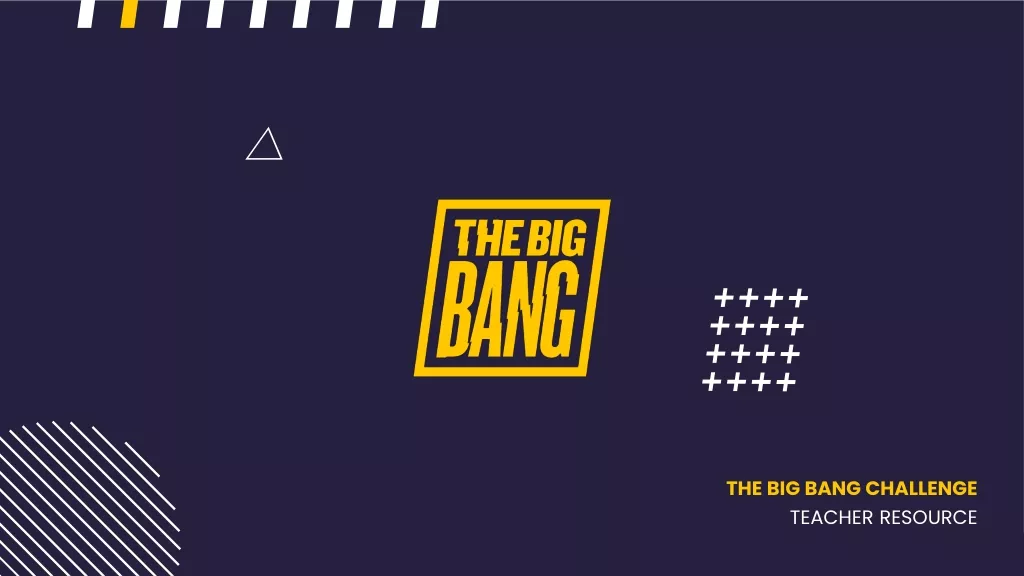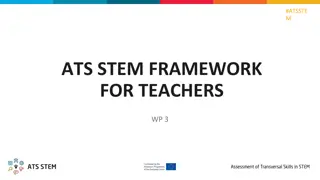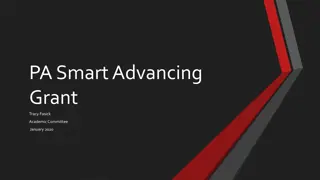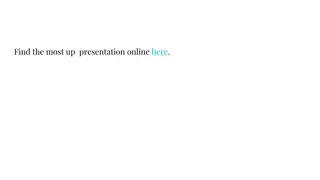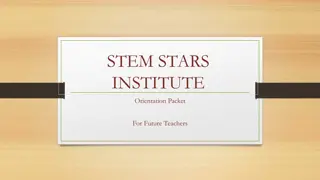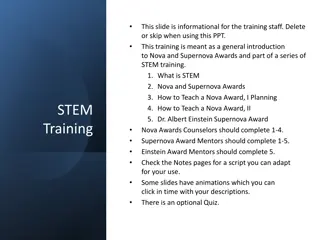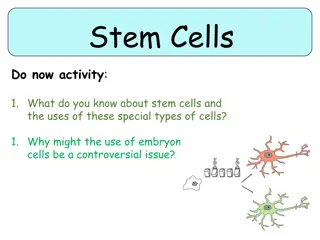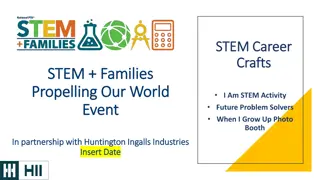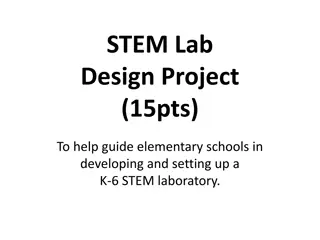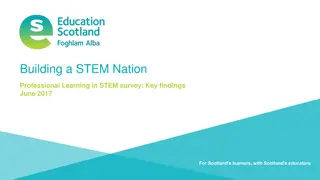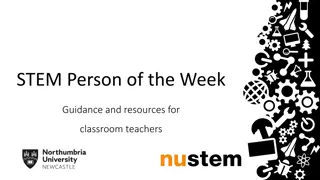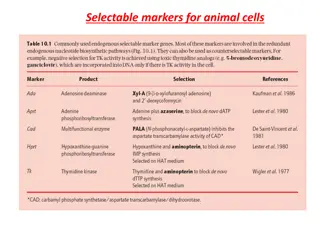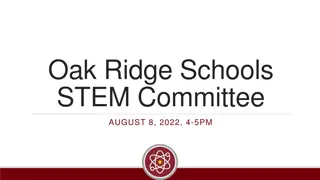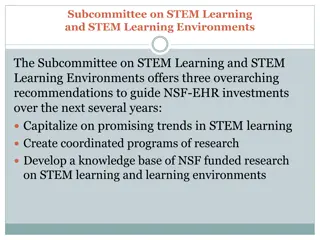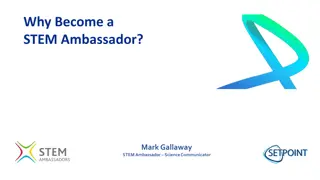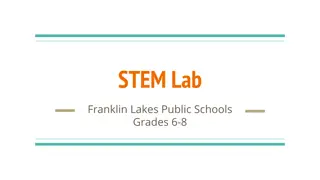Overview of Pre-K STEM Standards Development
Explore the evolution of Pre-K Science, Technology, Engineering, and Mathematics (STEM) standards, highlighting the importance of defining and emphasizing STEM in early education. The process includes revising State Pre-K-12 STEM standards and building upon existing frameworks, guidelines, and formative assessment tools. Standards focus on learning outcomes for children, distinct from curriculum and pedagogy. The discussion also delves into specific domains of knowledge in Math and English Language Arts.
Download Presentation

Please find below an Image/Link to download the presentation.
The content on the website is provided AS IS for your information and personal use only. It may not be sold, licensed, or shared on other websites without obtaining consent from the author.If you encounter any issues during the download, it is possible that the publisher has removed the file from their server.
You are allowed to download the files provided on this website for personal or commercial use, subject to the condition that they are used lawfully. All files are the property of their respective owners.
The content on the website is provided AS IS for your information and personal use only. It may not be sold, licensed, or shared on other websites without obtaining consent from the author.
E N D
Presentation Transcript
The Development of Pre-K Science, Technology, and Engineering Standards 2012 MA PRE-STEM and STEM Summit October 17&18, 2012 Karen Worth Wheelock College kworth@wheelock.edu
Why New Pre-K STE Standards? It is an opportunity to define the nature and substance of Pre-K STE It is an opportunity to emphasize the importance of STE in Pre-K A State Pre-K- 12 STE revision process is underway
Building on What We Know and Have Frameworks The Curriculum Framework for English Language Arts and Literacy (March 2011): Standards for Pre-Kindergarten and Kindergarten The Curriculum Framework for Mathematics (March 2011): Standards for Pre-Kindergarten and Kindergarten Head Start Child Development and Early Learning Framework
Building on What We Know and Have Guidelines The Early Learning Guidelines for Infants and Toddlers (November 2010) The Guidelines for Preschool Learning Experiences (April 2003) in all domains except English Language Arts and Mathematics The Kindergarten Learning Experiences (April 2008) in all domains except English Language Arts and Mathematics Headstart
Building on What We Know and Have Formative Assessment Tools The Work Sampling System High Scope Child Observation Record Teaching Strategies Gold: Assessment System
The Nature of Standards Standards are Learning outcomes what children need to know and be able to do Standards are not Curriculum Pedagogy
A Word About MATH Domains of Knowledge from The Curriculum Framework for Mathematics (March 2011) Counting and Cardinality Operation and Algebraic Thinking Measurement and Data Geometry
A Word About ELA Domains of Knowledge from The Curriculum Framework for English Language Arts and Literacy (March 2011) Reading Standards for Literature Reading Standards for Informational Text Reading standards: foundational skills Language Standards Writing Standards Speaking and Listening Standards
STE Standards and the Whole Child Curiosity and play Mathematics (THE M IN STEM) English Language Arts (ELA) Physical development and motor skills Social and emotional development Approaches toward play and learning Language and communication development
Characteristics of STE Interesting and engaging Developmentally appropriate and child-centered Conceptually based Real world based Reasoned and reflective Challenging Integrated with other domains Integrated within children s play
Video Is this math? Is this literacy? Is this science? Is this thinking skills? Is this social and emotional development? Is this physical development?
Video Is this math? Geometry, number, measurement Is this literacy? Communication, description, vocabulary Is this science? Forces, equilibrium, balance Is this thinking skills? Problem solving, designing, questioning Is this social and emotional development? Cooperation, handling challenge and frustration Is this physical development? Large and small muscle control, hand-eye coordination
Pre-K STE Standards Work in Progress/Process Based in a National Framework and the on-going work of revision of the MA Frameworks for Science, Technology and Engineering Three domains Practices of science and technology Cross-cutting concepts Disciplinary core ideas
Dimension 1: STEM Practices Asking questions (science) and solving problems (engineering) Math Framework: Make sense of problems and persevere in solving them Developing and using models Math Framework: Model with mathematics Planning and carrying out investigations Math Framework: Reason abstractly and quantitatively Analyzing and interpreting data Math Framework: Reason abstractly and quantitatively
Dimension 1: STEM Practices ctd Using mathematics and computational thinking Math Framework: Reason abstractly and quantitatively Constructing explanations (science) and designing solutions (engineering) Engaging in argument from evidence Math Framework: Construct viable arguments and critique the reasoning of others Obtaining, evaluating, and communicating information
Dimension 1: Practices The following diagram, taken from A Framework for K-12 Science Education suggests the way in which the practices interact and describe the scientific and engineering process. Theories and Models The Real World Imagine Reason Calculate Predict Ask Questions Observe Experiment Measure Argue Critique Analyze Formulate Hypotheses Propose Solutions Collect Data Test Solutions Developing Explanations and Solutions Investigating Evaluating
Dimension 2: Cross-Cutting Concepts Patterns Recognize, classify, and record patterns Cause and Effect Mechanism and Explanation Look for and analyze patterns and relationships and what causes the patterns; design tests to confirm or deny Scale, Proportion and Quantity Work with objects and space and explicit models
Dimension 2: Cross-Cutting Concepts Systems and System Models Describe things in terms of parts, roles of parts, and relationship among parts Structure and Function Investigate accessible and visible systems in nature and human- built world Stability and Change Explore building, climbing, growth
Dimension 3: Disciplinary Core Ideas Influences on the selection of content Research Appropriate challenge Children s interest, curiosity, and their environment Articulation with K-12 (progressions of learning) STE key ideas
The structure of a STE standard What the structure will do: Identify STE learning outcomes Highlight content in the context of practices and cross-cutting ideas - not information Identify connections math and ELA frameworks What the structure will not do: Define curriculum Define pedagogy Explicitly connect to other development goals (e.g. physical, socio-emotional, etc.)
Core & Component Ideas in Physical Sciences Properties and change in matter Motion Energy: sound Energy light and shadow
Sample Standard Physical Science: Motion Children who demonstrate understanding: Canplan and carry out investigations of the behaviors of moving things such as balls on inclined planes or kites in the air. Math Connections Use comparative language such as more/less than, equal to, to compare and describe collections of objects. Recognize the attributes of length, area, weight and capacity of everyday objects using appropriate vocabulary (e.g., long, short, tall, heavy, light, big, small, wide, narrow). Sort, categorize and classify objects by more than one attribute.
Sample Standard Physical Science: Motion Children who demonstrate understanding can: Plan and carry out investigations of the behaviors of moving things such as balls on inclined planes or kites in the air. Books Bradley, Kimberly. Forces Make Things Move. (Let s Red and Find Out) Yolen, Jane. The Emperor and the Kite. Puffin Cobb, Vicki. I Fall Down. HarperCollins McCully, Emily Arnold. Mirette on the High Wire. Puffin.
Sample Standard Physical Science: Motion Children who demonstrate understanding can: Describe changes in movement (slowing down, speeding up) and use physical evidence to explain reasons for the change. Make predictions about and demonstrate how objects will move (speed and direction) when pushed or pulled in different ways. Math Connection Identify relative position of objects in space, and use appropriate language (e.g., beside, inside, next to, close to, above, below, apart.
Sample Standard Physical Science: Energy, light and shadow Children who demonstrate understanding can: Demonstrate and share ideas about how to make a shadow change size and shape. (Math: measurement, shape) Make predictions about the shape of a shadow based on the object. Math Connections Use comparative language such as more/less than, equal to, to compare and describe collections of objects. Recognize the attributes of length, area, weight, and capacity of everyday objects using appropriate vocabulary (e.g., long, short, tall, heavy, light, big, small, wide, narrow). Identify relative position of objects in space, and use appropriate language (e.g., beside, inside, next to, close to, above, below, apart).
Sample Standard Physical Science: Energy, light and shadow Children who demonstrate understanding can: Demonstrate and share ideas about how to make a shadow change size and shape. (Math: measurement, shape) Make predictions about the shape of a shadow based on the object. Books Cobb, Vicki. I See Myself. HarperCollins Lee, Suzy. Shadow. Chronicle Book
Core & Component Ideas in Life Sciences Organisms (plants and animals including humans) Parts Characteristics Structures Functions and needs Growth and development How organisms meet their basic needs in their environments and the many kinds of living things in one area
Sample Standard Life Science: How organisms meet their basic needs in their environment Children who demonstrate understanding can: Explain how some plants and animals in their local might meet their basic needs. Math Connection Sort, categorize, and classify objects by more than one attribute. Make reasoned predictions about how changes in the environment might effect the living things that depend on it
Sample Standard Life Science: How organisms meet their basic needs in their environment Children who demonstrate understanding can: Explain how some plants and animals in their local might meet their basic needs. Make reasoned predictions about how changes in the environment might effect the living things that depend on it. Books Gilbertson, B. Z. Cactus Hotel. Henry Holt Mazer, Anne. Salamander Room. Dragonfly Books Gibbons, Gail. From Seed to Plant. Holiday House
Core & Component Ideas in Earth and Space Sciences The sun/moon and their predictable apparent motion The non-living materials of the environment Water in the environment Elements of daily weather
Sample Standard Earth Sciences: Elements of daily weather Children who demonstrate understanding can: Collect and record data on daily weather and use data to determine simple patterns. Math Connection Listen to and say the names of numbers in meaningful contexts. Use comparative language such as more/less than, equal to, to compare and describe collections of objects.
Sample Standard Earth Sciences: Elements of daily weather Children who demonstrate understanding can: Collect and record data on daily weather and use data to determine simple patterns. Books Ets, Marie Hall. Gilberto and the Wind. Picture Puffin Cobb, Vicki. I Face the Wind. HarperCollins Cynthia Rylant. Snow. Harcourt Children s Books
Technology and Engineering Ideas and skills of Engineering and Technology will be integrated with the science standards
Current State Supports The Educator and Provider Support Grantees (EPS) funded by The Massachusetts Department of Early Education and Care support professional development for the early childhood field and providers across the state. The Regional Readiness Centers are also a source of support for professional development for early childhood educators and providers across the state.
Current State Supports Professional development opportunities are offered to center- based, family child care and out of school time providers through the following resources: The Massachusetts Department of Early Education and Care Professional Development Catalogue http://www.eec.state.ma.us/docs1/Workforce_Dev/20120207_fy 2012_edu_provider_crse_catalogue.pdf EEC Online courses offered on EECs website http://www.mass.gov/edu/birth-grade-12/early-education-and- care/workforce-and-professional-development/training-and-orientation- resources/free-competency-based-training-online.html
Current State Supports Last year the Regional Readiness Centers provided train the trainer sessions on the Massachusetts Curriculum Frameworks for English Language Arts and Mathematics.. Currently with funding through the Race to the Top Early Learning Challenge grant Readiness Centers will be offering 4 professional development opportunities related to early learning standards annually. These opportunities will be trainings and or courses that will award academic currency (CEUs or 1.0 college credit). Readiness Centers are also working with the Educator and Provider Support Grantees to offer joint professional development opportunities across the state.
Current State Supports EPS grantees work with The Wheelock College Aspire Institute Center for Assessment and Screening Excellence(CASE), to offer professional development opportunities providing statewide training and technical assistance in early childhood assessment, screening and program measurement aligned with MA Quality Rating and Improvement System (QRIS). (EEC funded initiative) There are several CEU and college credit courses offered through the EPS grantees for STEM and Early Learning Standards. (see STEM booklet in your packet and Course Catalogue on EECs website)
Current State Supports Statewide: Number of Proposed Opportunities by Areas of Alignment 81 Infant Toddler Guidelines 115 Preschool Guidelines 119 MA Curriculum Frameworks 142 EEC Regulations 221 QRIS 0 50 100 150 200 250
Timeline 1. Draft of the standards (December 31st, 2012) 2. Public review (January-March, 2013) 3. Final version ( June 30, 2013
Questions to Consider What is important to include in the STE standards? What are some concerns about STE standards and how might they be met? In what ways might we emphasize direct experience, integration, and play? What are some strategies for making the STE standards as useful as possible to the field? How best might we communicate the content and spirit of the STE standards to parents
Questions to Consider What do we want children to know? What do we want educators to know? How do we build/encourage curiosity in children of all ages and stages of development? What curriculum changes can occur? What resources are needed? What resources exist?



